The Very BEST Whole Wheat Bread
The Very BEST Whole Wheat Bread is the softest, moistest, fluffiest, freshest-staying, homemade, 100% whole wheat bread you've ever tried!
This bread, y'all. This bread. I titled this Whole Wheat Bread recipe "the BEST" and I'm not even exaggerating here. I've baked many a whole wheat bread recipe over the years, and this one is head-and-shoulders above the rest.
Hundreds of raving comments (since I first published this recipe six years ago) can't be wrong...right?! So I decided to update this old post with tons of additional information and tips to help ensure your bread making success!
THE BEST Whole Wheat Bread
Here's the deal...what makes this bread so amazing is that it stays soft and fresh for days after it's been baked.
Just about all homemade bread tastes fabulous fresh out of the oven. But then whatever isn't initially eaten tends to dry out a bit as the days stretch on, particularly in the case of wheat bread.
But this bread is just as good on the third day (if it lasts that long!) as it was on the first. Seriously! I wouldn't believe it if I hadn't experienced it first hand myself. It's like store-bought, stay-soft bread without the preservatives. Forgive me for going all Scarlett O'Hara on you, but as God is my witness, I'll never make another whole wheat bread recipe again!
The Best Whole Wheat Flour for Bread Baking
One of my bread making tricks is that I like to use white whole wheat flour when I make bread. Even though it has the word "white" in its title, this flour is 100% whole wheat.
Traditional whole wheat flour is milled from red wheat; white whole wheat flour is milled from (hard) white wheat. Its lighter grain results in a milder flavor and lighter texture than the whole wheat flour to which most of us are accustomed.
Don't be fooled by the taste, though...white whole wheat flour is unrefined and 100% whole wheat! It's nutritionally the same as its red wheat cousin. I buy King Arthur brand unbleached white whole wheat flour, but I'm sure there are other brands out there that would work just as well.
How to Make the Best Whole Wheat Bread
Not only does this whole wheat bread turn out better than most, but the recipe is actually simpler to make than most! Some of the steps may seem a bit unconventional to an experienced bread maker. But if you give this recipe a chance, I think you'll be pleased with the results.
- Fit your stand mixer with a dough hook. Measure out flour, vital wheat gluten, and instant dry yeast into the bowl and mix until combined.
- Pour in very warm water (between 120°F and 130°F) and mix for one minute. The water needs to be hot enough to activate the yeast but not so hot that it kills it.
Cover with a clean kitchen towel and allow to rest for 10 minutes.
- Uncover the bowl.
Beat in salt, oil, honey, and lemon juice.
- Add more flour, mixing it in one cup at a time until well incorporated. Allow the dough hook to knead the dough until it becomes smooth instead of sticky and pulls away from the side of the bowl.
This typically takes 10 to 15 minutes but may take as little as 5 minutes.
- Grease and/or line your pans and set aside.
- Turn on the oven to 350°F. After exactly one minute, turn it back off. This will preheat the oven to lukewarm...just enough to give your loaves the perfect warm spot to rise!
- Turn the dough out onto a greased surface.
Divide it equally in half and shape it into two loaves.
Transfer the loaves to the prepared bread pans, pressing the dough into the corners.
- Place the pans in the warm oven and allow them to rise for 20 to 40 minutes, or until they are nicely domed and as high as you wish your final whole wheat bread loaves to be.
- Once the loaves have risen to your liking, turn on the oven to 350°F WITHOUT TAKING THE BREAD OUT OF THE OVEN. Set the timer for 30 minutes. I know, I know...sounds weird. But trust me.
- Your bread is done when it's golden brown on top with an internal temperature from 190°F to 200°F on an instant-read thermometer. Turn the hot loaves out onto a rack to cool completely.
And that's it. One step at a time...you can do this!
What's a Bread Sponge?
Let's talk about step #2 for a moment, shall we? I believe that the biggest factor that makes this bread stay so soft and fresh is the step in the recipe calling for you to make a sponge. Now I'm not talking about the kind of sponge you keep by your kitchen sink. In bread making, a sponge is a very moist dough that just begins to rise as it gives the yeast a head start. After it's had some time to do its magic, you add more flour and ingredients and proceed with the recipe. The sponge in this recipe only needs to sit for about 10 minutes. But apparently that's all it takes to achieve this bread's wonderful texture.
Ingredient Substitutions
For optimal results, make this whole wheat bread as directed. However, the recipe will still work (and even turn out great) incorporating a variety of substitutes. Just keep in mind that changing the ingredients may result in a different taste and/or texture in your final loaves. Switching ingredients could also require you to tweak an amount or a step, such as needing to add extra flour and/or kneading a bit longer to achieve the proper dough consistency. But if you're willing to experiment a bit, people have had success with the following substitutions...
(NOTE: Many of the below recipe tweaks have been taken from the comment section. I have not tried all of these substitutes myself.)
- Flour. You can make this recipe with regular (as opposed to "white") whole wheat flour. Or you may substitute all-purpose white flour for around half of the whole wheat flour. You may also use freshly ground whole wheat flour (milled from red wheat or white wheat). Just keep in mind that fresh milled flour is much "airier," so you may need to allow it some time to pack down before measuring it out...or just plan on using extra flour, as necesary. Also, with any flour substitution, you may need to slightly adjust the amount of flour added at the end of the recipe. For example, if the dough seems extra sticky and doesn't start pulling away from the bowl in a timely manner, you can work in additional flour (one spoonful at a time) until the texture seems right.
- Vital Wheat Gluten. This ingredient helps whole wheat bread recipes rise, and it encourages soft and chewy loaves with that stay-fresh quality. That being said, if you don't have any on hand or prefer not to use it, many people report having made this bread successfully while leaving out the vital wheat gluten.
- Yeast. I recommend using instant dry yeast (sometimes called "quick rise" or "rapid rise"), as directed in the recipe. You might have success if trying regular active dry yeast...but then again, maybe not. 😉 If you do decide to gamble on active dry yeast, my research indicates that to substitute it for instant dry yeast, you should multiply the amount by 1.25.
- Lemon Juice. If you don't have any lemon juice on hand, you may substitute another type of acid in its place. Orange juice, white vinegar, or apple cider vinegar would all work.
- Honey. You may reduce the honey, if you wish. Also, maple syrup or agave may be substituted for the honey.
Other Recipe Notes
- The stand mixer pictured in this post is a classic, 5-quart, tilt-head KitchenAid.
- You may halve this recipe to make only one loaf of bread.
- You can also make this bread by hand...just prepare your muscles for all of that kneading.
- People have also reported success in halving the ingredients and making this recipe in a bread maker. But I don't own a bread maker and I'm not sure of the specifics...so you may have to experiment on that one. 😉
Avoiding Sticking
The only difficulty that I ran into the first time I made this bread is that it stuck to my loaf pans, despite the fact that I had generously greased them. Nonstick pans are recommended for this recipe, so if you've got 'em, use 'em! But since I prefer baking in my stoneware pans, I figured out a way around not using nonstick.
I grease my pans with coconut oil and then line them with parchment paper, using the coconut oil to adhere the paper to the pan. I find that if I cut a piece of parchment paper the length of each pan and allow it to somewhat stick out the sides, then I only need to cut two small pieces of paper per pan for the ends that remain uncovered. The key is pressing the parchment paper down and smoothing it as much as possible so you don't end up with a bunch of creases in your bread.
How to Store Your Whole Wheat Bread
This recipe makes two loaves, so I like to keep one wrapped (I use Glad Press 'n Seal) and stored in the pantry for eating. The second loaf I keep wrapped up in the refrigerator until we're ready to enjoy it.
I have a bread box, but I still prefer keeping my loaf wrapped inside of the bread box. And when I cut off the first slice, I store that end piece pressed against the cut end of the loaf as a kind of "cap" to help prevent it from drying out. When we're ready for the second loaf, I take it out of the fridge and store it at room temperature in the bread box.
Since this is fresh homemade bread with no preservatives, it will start to mold after several days. So keeping that second loaf in the fridge until we're ready for it buys us some extra time. You could also successfully freeze the second loaf if you prefer. However, we usually eat it soon/fast enough that refrigerating suffices.
If it takes your family awhile to work through two loaves of bread, another winning alternative would be to give the second loaf away! I mean, who wouldn't love the thoughtful gesture of freshly-baked homemade bread?
If you have never baked homemade bread before, I encourage you to try it. It may seem intimidating at first and the various steps do take a bit of time, but overall, it truly is easy. And if you are already an expert baker, then I hope you'll add this recipe to your repertoire!
Now go forth and make bread!
And psssst...if you happen to love this bread recipe, I actually adapted it to make The Very BEST Whole Wheat Dinner Rolls! Your holiday table won't be the same without 'em. 😉
Whole Wheat Bread Recipe
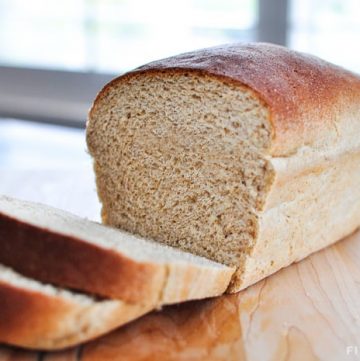
The Very BEST Whole Wheat Bread
Ingredients
Step 1:
- 3 ½ cups white whole wheat flour
- ⅓ cup vital wheat gluten
- 4 teaspoons instant dry yeast, "quick rise" or "rapid rise"
Step 2:
- 2 ½ cups very warm water, 120°F to 130°F
Step 3:
- 1 tablespoon salt
- ⅓ cup coconut oil, melted and cooled (OR vegetable oil)
- ⅓ cup honey
- 4 teaspoons lemon juice
Step 4:
- 2 ½ cups white whole wheat flour
Instructions
- In the bowl of a stand mixer fitted with a dough hook, mix together 3 ½ cups white whole wheat flour, vital wheat gluten, and quick-rise yeast until well combined.
- Add the water and mix for one minute, scraping down bowl halfway through. Cover the bowl with a clean kitchen towel and allow to rest for 10 minutes.
- Uncover the bowl and add the salt, oil, honey, and lemon juice. Beat for 1 minute.
- Add the remaining 2 ½ cups of flour, one cup at a time, mixing well between each cup. Knead the dough in the mixer (still using the dough hook) until the dough pulls away from the sides of the bowl and feels smooth rather than sticky. This usually takes 10 to 15 minutes, but if your dough pulls away and loses its stickiness sooner, it could take as little as 5 minutes.
- Grease two nonstick bread pans measuring 8 ½" x 4 ½" x 2 ½" to 9" x 5" x 3" each (or grease two regular bread pans and then line them with parchment paper). Preheat the oven to lukewarm by setting it to 350°F and then turning it back off after exactly 1 minute.
- Turn the dough onto a greased surface. Evenly divide it into two loaves. Form and place the dough into the prepared bread pans, gently pressing it into the corners.
- Place the pans in the warm oven and allow them to rise for 20 to 40 minutes, until the dough is nicely domed above the tops of the pans. Without removing the pans from the oven, turn on the oven to 350°F and set the timer for 30 minutes. The bread is done when the tops are golden brown and the internal temperature reaches 190°F to 200°F on an instant-read thermometer. Once the loaves are baked, immediately remove the hot bread from the pans to cool on a rack.
Equipment Needed
Notes
- I use coconut oil in this recipe. It works wonderfully and doesn't make the bread taste like coconut at all. However, you may use sunflower, safflower, or another light-flavored vegetable oil, if you prefer.
- Kneading and rising times are approximate and depend on many different variables. The dough must be kneaded until it pulls away from the bowl and is no longer sticky, even if that takes shorter or longer than 10 to 15 minutes. Also, the dough should be allowed to rise in the pans until it is as high as you want your final bread to be.
- White whole wheat flour is 100% whole wheat flour that yields a lighter taste and texture than regular whole wheat flour.
- Other types of flour (regular whole wheat flour, all-purpose white flour, freshly milled wheat flour, etc.) may be substituted for the white whole wheat flour in this recipe. Just keep in mind that the final flavor and texture of the bread may turn out different. Also, if you use an alternate flour (particularly freshly milled flour, which can be less dense), you may need to slightly adjust the amount of flour added at the end of the recipe. For example, if the dough seems extra sticky and doesn't start pulling away from the bowl, you can work in additional flour, one teaspoon at a time, until the texture seems right.
- If you don't have any lemon juice on hand, you may substitute another type of acid in its place (such as white vinegar or apple cider vinegar).
- Vital wheat gluten helps whole wheat bread recipes rise and yield soft and chewy loaves. That being said, if you don't have any on hand or prefer not to use it, many people report having made this bread successfully leaving out the vital wheat gluten.
Nutrition
Recipe adapted from Deals to Meals.
Post originally published on July 8, 2013.

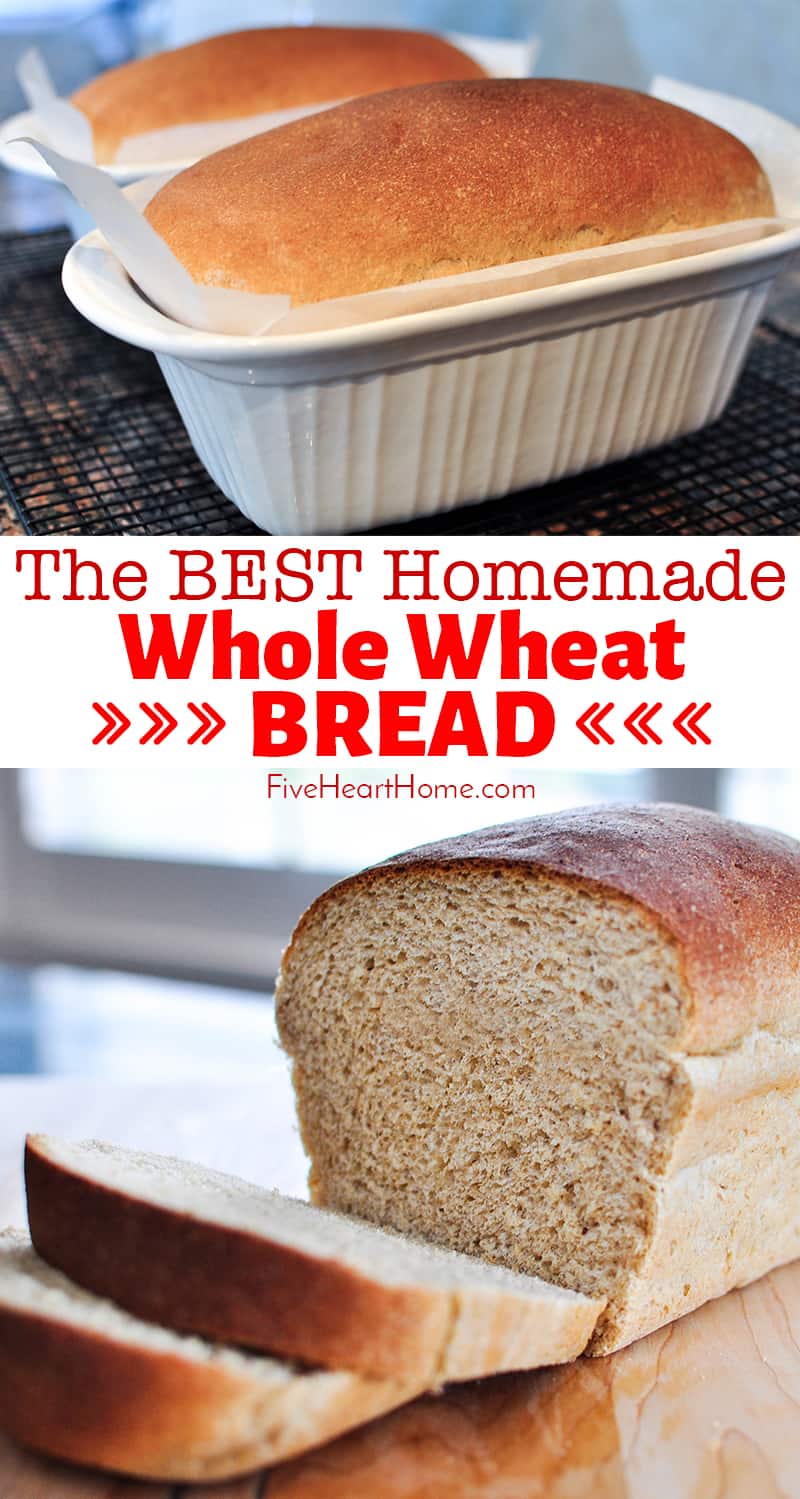
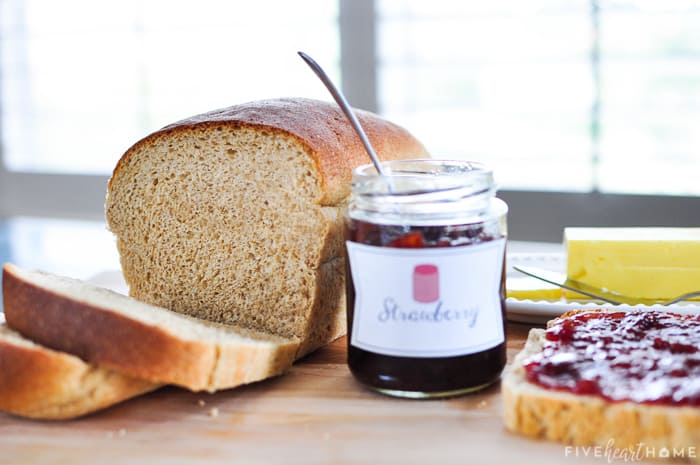
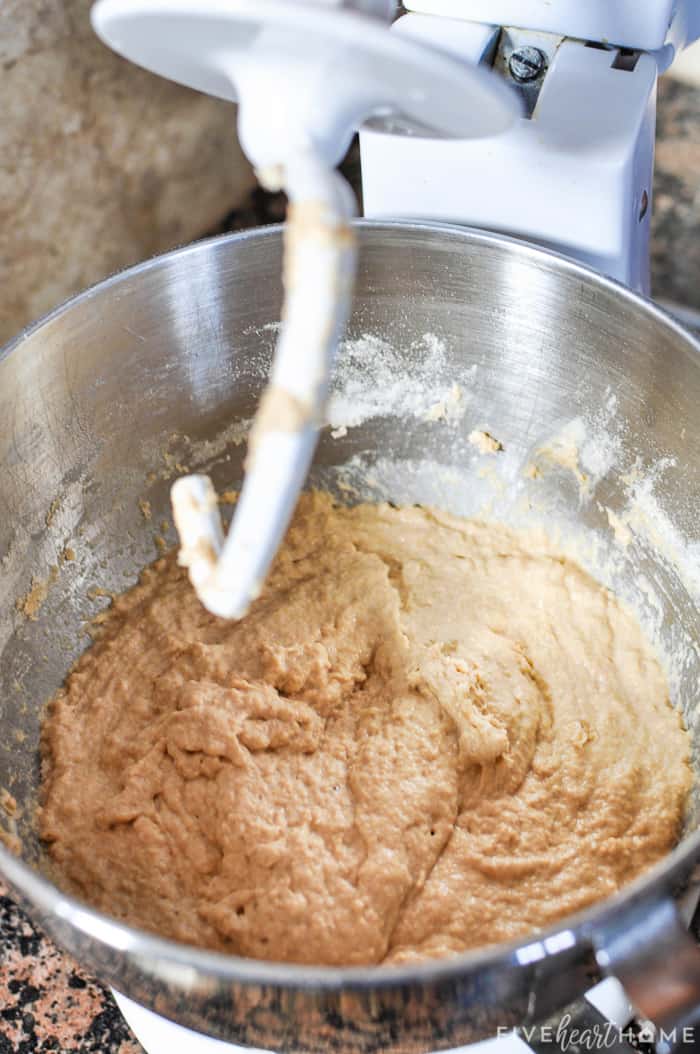 Cover with a clean kitchen towel and allow to rest for 10 minutes.
Cover with a clean kitchen towel and allow to rest for 10 minutes.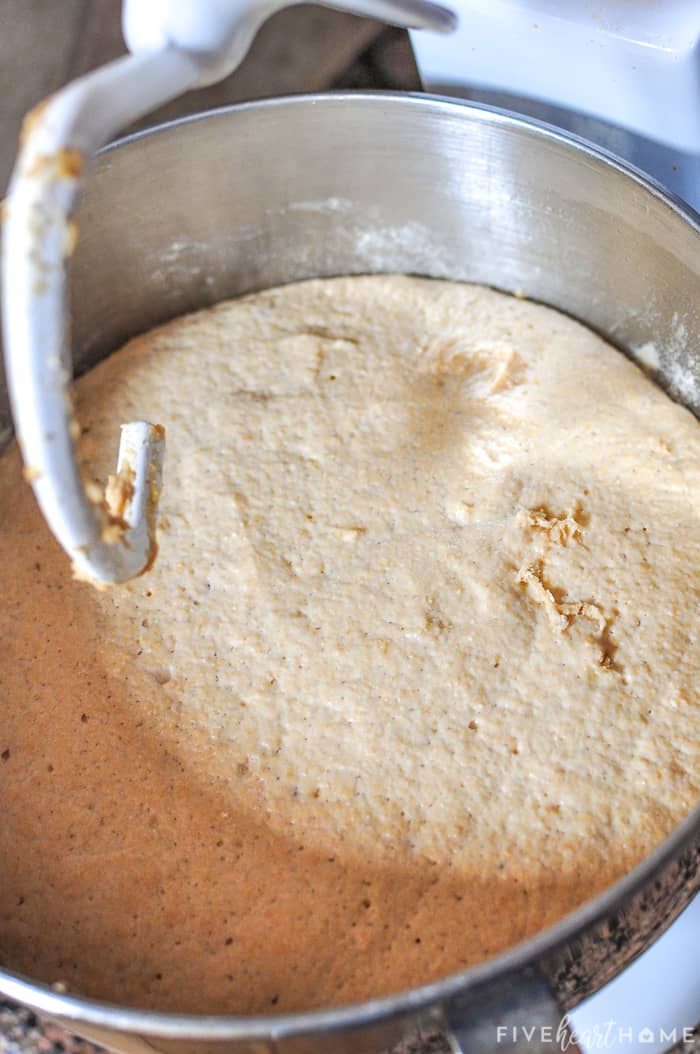 Beat in salt, oil, honey, and lemon juice.
Beat in salt, oil, honey, and lemon juice.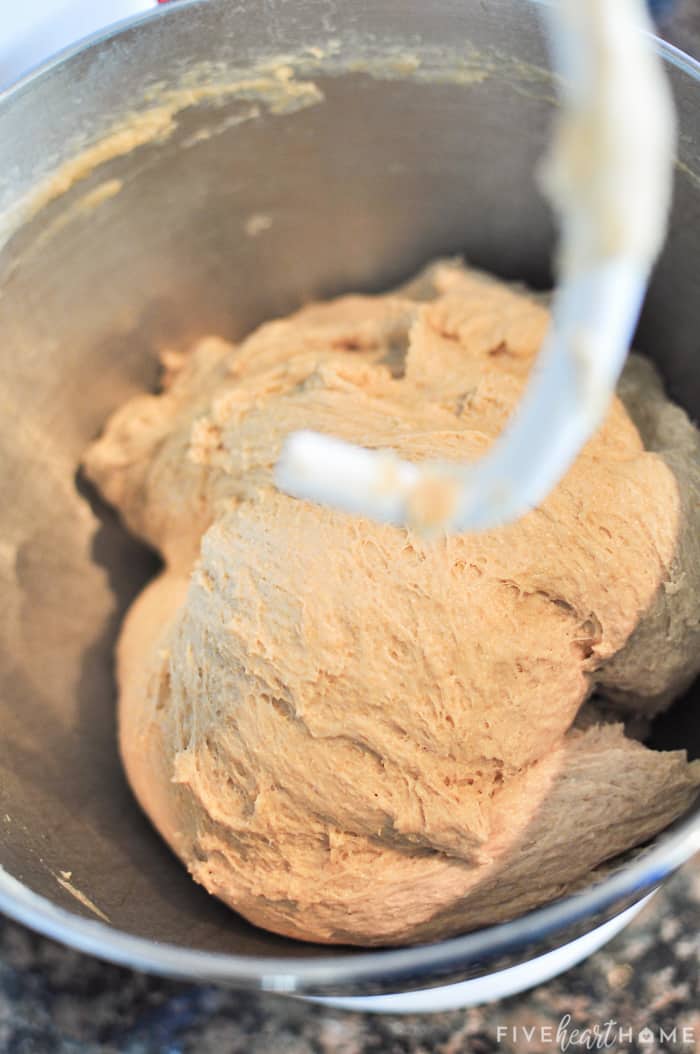 This typically takes 10 to 15 minutes but may take as little as 5 minutes.
This typically takes 10 to 15 minutes but may take as little as 5 minutes.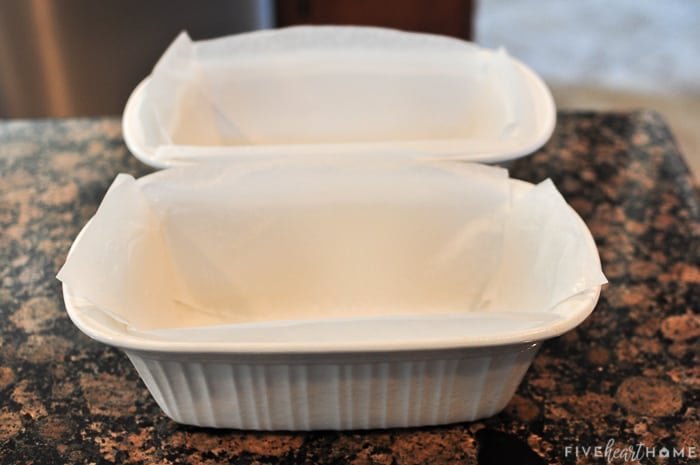
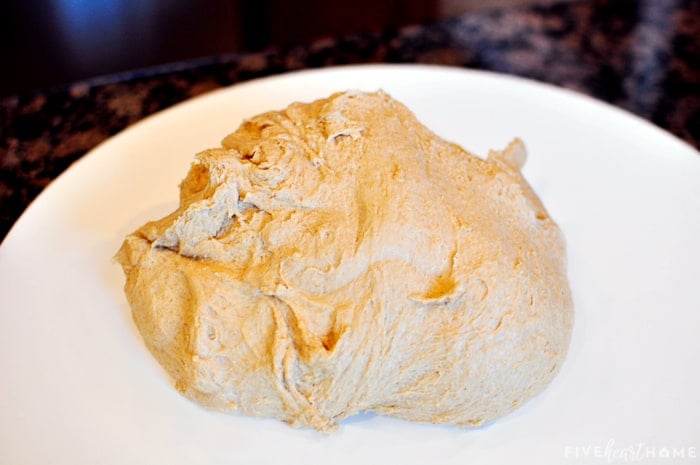 Divide it equally in half and shape it into two loaves.
Divide it equally in half and shape it into two loaves.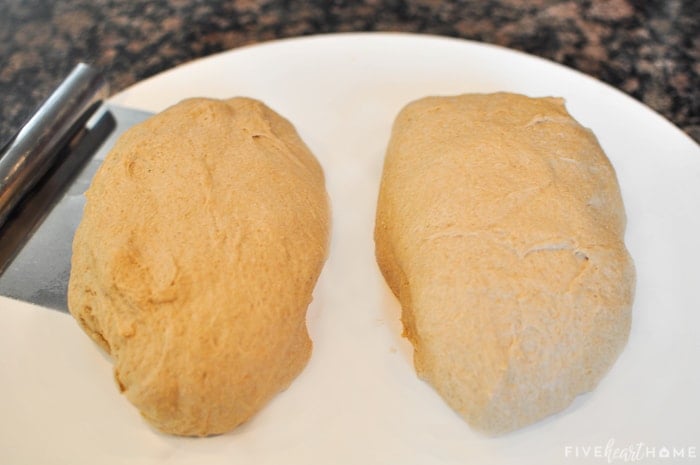 Transfer the loaves to the prepared bread pans, pressing the dough into the corners.
Transfer the loaves to the prepared bread pans, pressing the dough into the corners.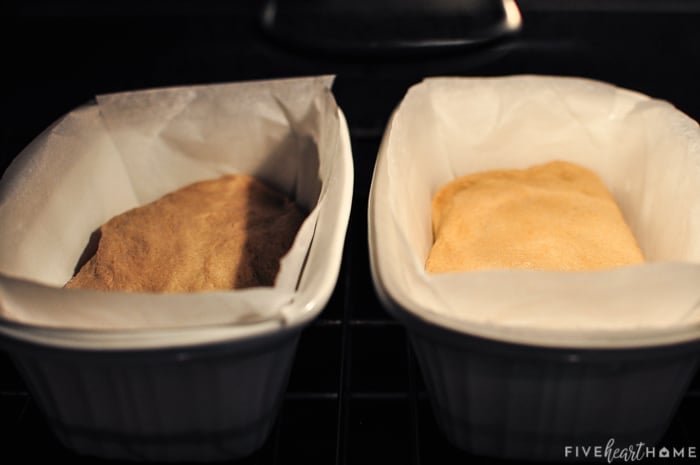
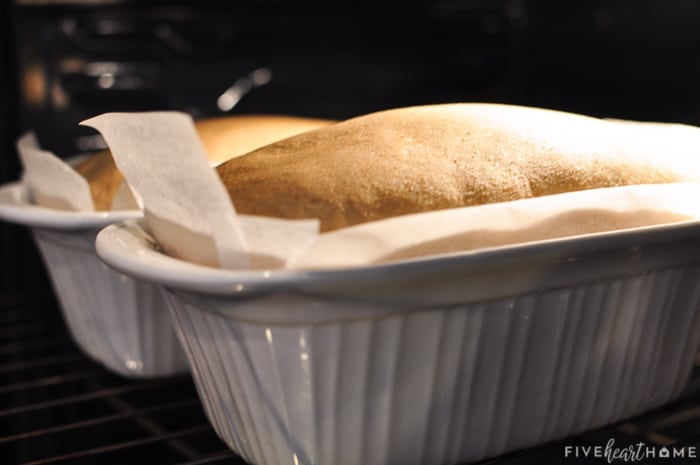
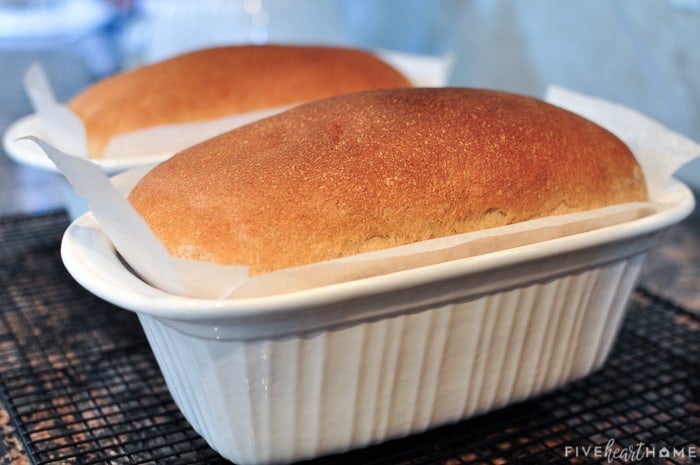
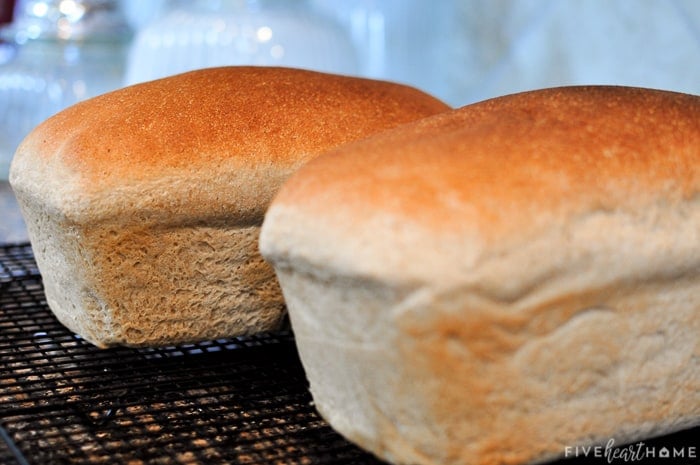
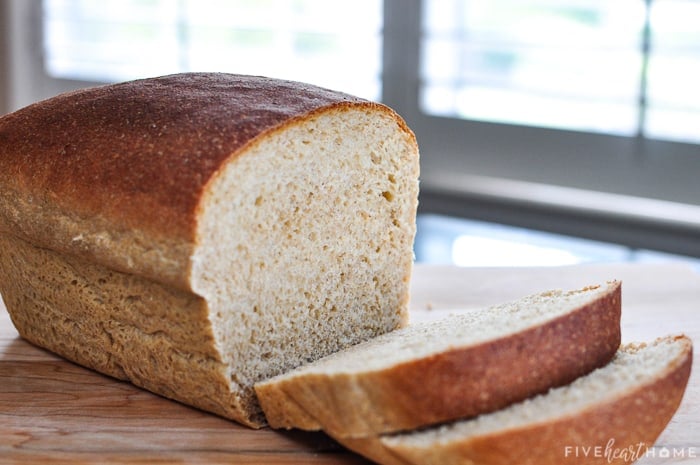
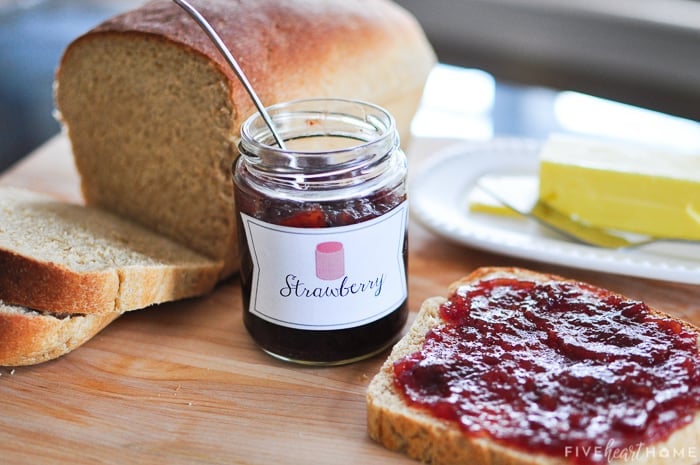
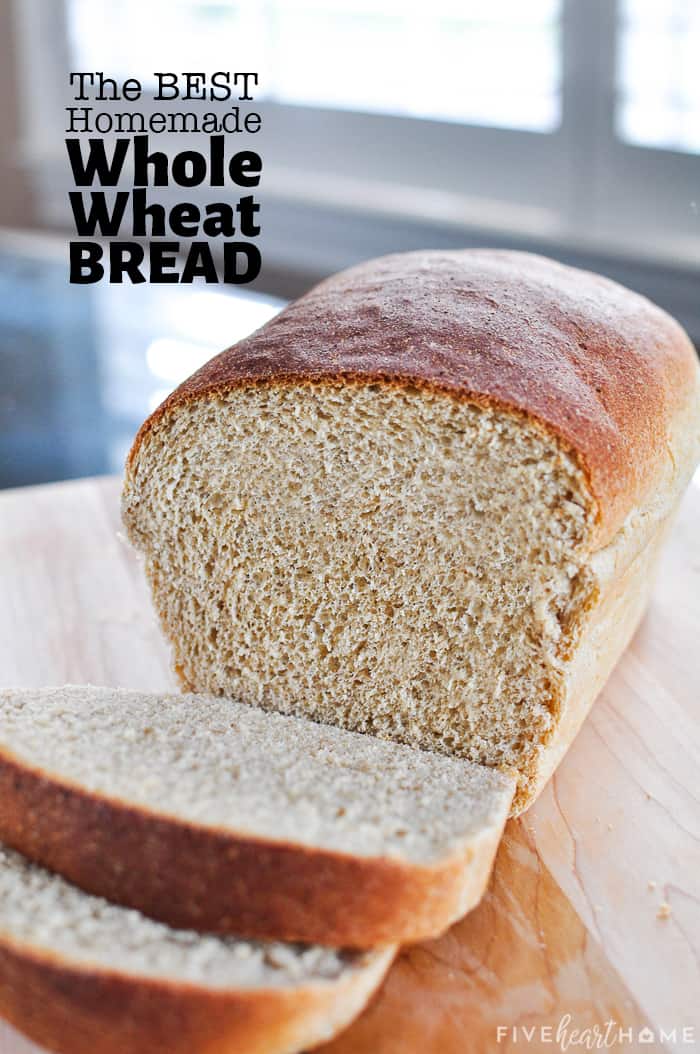
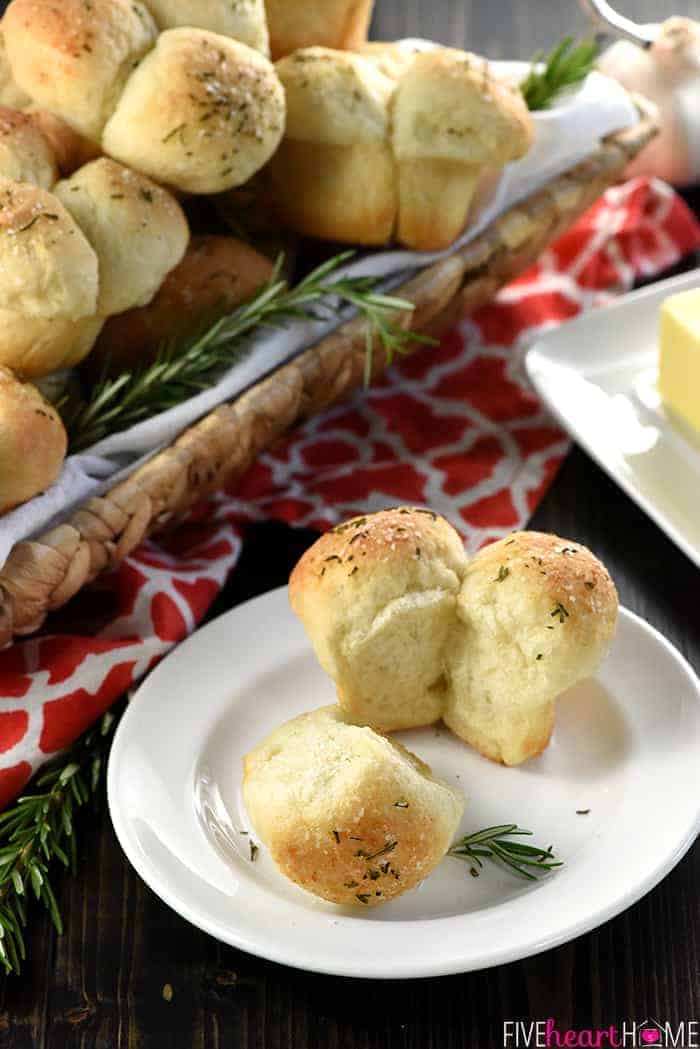
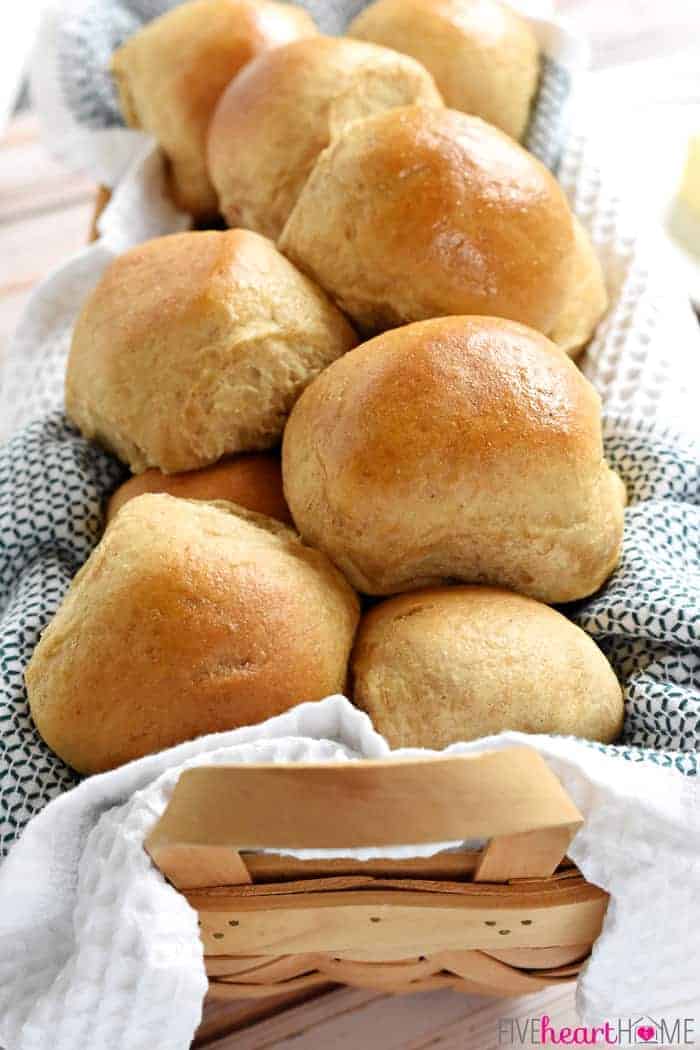
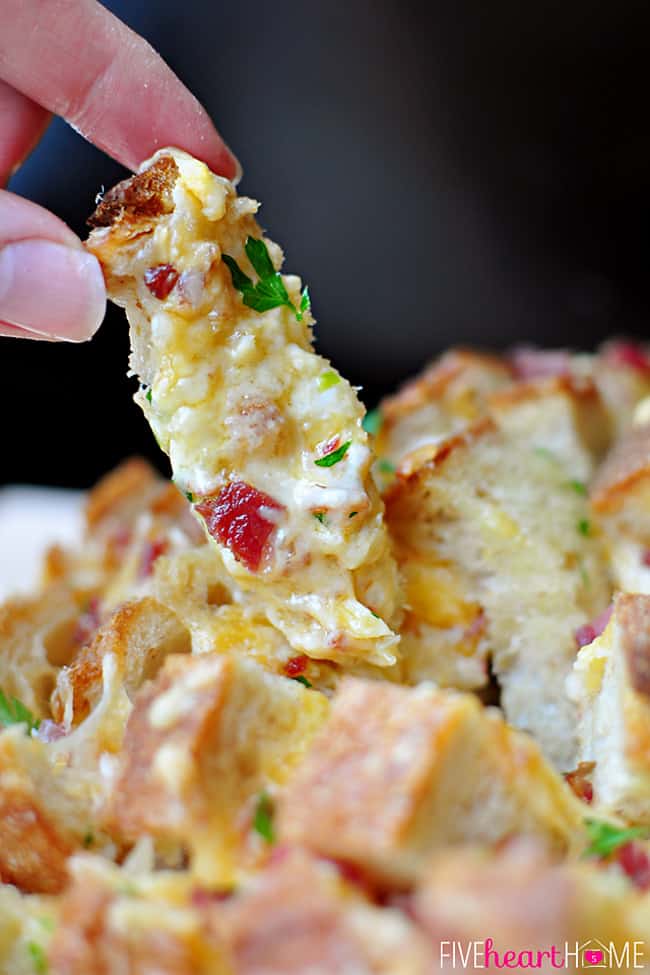
I am really excited to try out this recipe!! I have been trying to find high quality all natural bread in the stores and they are either pricey, not completely natural or just have a weird texture. Not sure why it took me this long to just try and make my own when I try so many other diy projects.
I do not have any vital wheat gluten but I do have xanthan gum (powder form) that I use for other things. Do you know how much xanthan gum I would need to replace the wheat gluten called for in this recipe?
Thanks again 🙂
Hi Bella! I've never tried using xantham gum as a substitute for vital wheat gluten, so unfortunately, I don't have any advice in regards to that. However, I can tell you that people have successfully made this bread without using the vital wheat gluten, so you can try leaving it out altogether if you wish. 🙂 Hope that helps and hope you enjoy your bread!
Samantha, I have made this very best whole wheat bread 3 times in the past two weeks. I love it and all of your claims are true, true, true! The first time I made it, it came out PERFECT! But the past two times it will not rise in the oven. What could I possibly be doing wrong? I keep your recipe in front of me and follow everything step by step. Could my oven not be warming to the correct temp when I turn it off one minute after I turn it to 350 degrees? (Even though it is not rising, it still tastes awesome.)
Denise
Hi Denise! I'm so glad you love this bread, but I'm sorry it hasn't risen properly the past couple of times you made it. The fact that it initially worked for you but now it doesn't could mean so many things. If it's not rising at all, is it possible that your yeast could be bad/expired? You can always test your yeast (using a method like this one). You also may have accidentally killed your yeast if the water you used in the recipe was too hot. Does the oven feel warm but not overly hot after 1 minute of preheating? It doesn't seem like anything should have changed with your oven if rising worked in it before and now it doesn't. Your problem could also have to do with the weather. Humidity and temperature can both affect bread baking. In some conditions, it's possible that the bread is just going to take a lot longer to rise, so it may need more time. But if it's not rising at all no matter how long you wait, I'm guessing it has something to do with your yeast...? Hope this gives you some ideas of what could have gone wrong, and good luck on your next try! 🙂
I don't have a stand mixer to do all the kneading. Sounds like doing it by hand would be very time consuming. Any suggestions?
Hi Kay! This recipe can definitely be made by hand, but as with any homemade bread recipe, it's going to take more time and muscle than making it with a stand mixer. 😉 Other than those two options, though, I'm not sure what to suggest? You could always try cutting the recipe in half and making it by hand. You'd only end up with one loaf of bread instead of two, but it would be less dough to mix and knead. Good luck if you decide to try it! 🙂
What size loaf pans do u use? My bread rose and then kind of overflowed the pans instead of dome and I was thinking I may be using wrong size pans. Thank u!
Hi Eli! I’ve made this recipe in a couple different types of “standard sized” (about 9″ x 5″ x 2 1/2″) bread pans that I have, and it worked fine in both. If you look just under the recipe, there is a link to the specific Corningware bread pan pictured in this post, which is 1 3/4-quart loaf dish. This pan does have sides that slightly slope inwards, but the opening is about the standard dimensions I mentioned above. This recipe also reportedly works fine in slightly smaller (8 1/2″ x 4 1/2″ x 2 1/2″) pans as well. Any pan in that size range should work. I'm not sure if your pan size was the problem, but it is possible for bread to overrise. At any rate, I hope it "domes" better for you if you decide to try the recipe again. 🙂
I've never made bread before and so your recipe was my first. It came out PERFECTLY. I am genuinely, never buying store-bought bread again. It's just the two of us, so one loaf lasts my family a whole week. I'm just getting ready to bake it for my second time! I followed it exactly, with the only modification being that I didn't use Quick-Rise yeast. I followed other instructions on other websites for the appropriate conversion and rise/cook times and it was a totally approriate substitution. Thanks so much for sharing this!
I'm thrilled that this bread was such a hit for you, Cassie! Thanks for taking the time to comment and I hope you enjoy this recipe for many years to come! 🙂
Here's an update for others who may want to do this: I tried it tonight with 3 1/2 cups white whole wheat & 2 1/2 cups AP flour & everything else as written in your recipe. After adding more flour (about a 1/2 cup) and kneading for 20 minutes, my dough pulled away from the sides of the bowl but it was still sticky. I was afraid to add too much flour so I went ahead and put it in the pan to rise anyway. It rose great - well over the top of the pan. When I baked it however, it sank on the top. It is moist and delicious just not so pretty. I see in the comments others have had this problem so I don't know if it was flour substitution or something else. Do you think I should have added more flour?
Adding a bit more flour until the dough was no longer sticky may have helped...the all-purpose flour could have required using a bit more to achieve the right consistency. Bread can fall after baking for a variety of other reasons -- for example, it wasn't baked quite long enough, or it was allowed to rise a bit too much -- but since you made this recipe successfully the first time using all whole wheat flour, I'm betting the partial substitution of white flour had something to do with the sinking this time. Glad it still tasted good, and I hope it works better for you if you decide to try again! 🙂
What size bread pans should I use? I'd love to make this today.
Hi Angela! I've made this recipe in a couple different types of "standard sized" (about 9" x 5" x 2 1/2") bread pans that I have, and it worked fine in both. If you look just under the recipe, there is a link to the specific Corningware bread pan pictured in this post, which is 1 3/4-quart loaf dish. This pan does have sides that slightly slope inwards, but the opening is about the standard dimensions I mentioned above. I think this recipe would work fine in slightly smaller (8 1/2" x 4 1/2" x 2 1/2") pan as well. Any pan in that size range should work. Hope that helps, and happy bread making!
Thanks Samantha! In case anyone else needs to know, I made it in 2, 8 1/2″ x 4 1/2″ x 2 1/2 size pans and it worked great. This is such good bread! Has anyone tried it w/ 1/2 AP flour? I'd like to make it for a friend who prefers white but I think with the white whole wheat .she'd like 1/2 & 1/2.
This recipe should work just fine using all-purpose flour in place of half of the white whole wheat flour. 🙂
This bread was delicious! I am back to make it again since both my husband and I really liked it. The bread rose perfectly and tasted great!
Wonderful, Charissa...I'm so happy to hear that this recipe was a hit! Hope y'all get to enjoy it many more times in the future. 😉 Have a great week!
hi i dont have/get the gluten what is the substitute?
Hi Barkha! Lots of people have reported making this bread without the vital wheat gluten and they said it still turns out great! So if you don't have it or prefer not to use it, it should be fine to simply leave it out. Enjoy! 🙂
Hi Samantha!
Can you pls help me with measurements. Approximately how many grams is the cup you use?
Thank you!
Hi Anna! I am not really familiar with converting cups into grams. However, I found several conversion calculators online, and they're telling me that 1 cup of whole wheat flour is equivalent to anywhere from 120 to 128 grams, depending on the brand of flour. Does this sound right? Sorry I can't be of more help...finding a reliable converter tool online is probably your best bet. 🙂
Absolutely the best and easiest wholewheat loaf to make. And everyone who eats it loves it. Seasoned bakers say it's the best whole wheat they have tasted.
I vary it slightly by using white unbleached bread flour for the 2 1/2 cups at the end.
Thanks
I love to hear that, Tom...so happy that this bread has been a success for you! Hope you enjoy it for many years to come... 🙂 Thanks for taking the time to comment and hope you're having a great week!
Hi Samantha! I just want to say I stumbled upon your blog looking for a recipe such as this, and I can't stop looking at all of your posts! I can't wait to try some of your other recipes.
I have made this recipe twice now and it tastes amazing! I do have a question though; what brand of flour do you use? I apologize if you have already answered this, I did try to read through all of the comments to see if you had mentioned it.
I ask because my bread has yet to turn out as fluffy and beautiful as yours and it has a rough top not smooth and glossy like yours. So, I have made a few tweaks to my technique, but I'm wondering if it isn't the brand of flour I'm using.
Thanks so much for such a great blog!
Hi Tina! Thanks so much for the sweet comment...I'm thrilled to hear that you are enjoying the blog, and I hope any other recipes that you might try are a hit! I can see below that you found the answer to your question before I had a chance to get back to you, so that's great. King Arthur is indeed the brand that I use, mainly because it's the only whole wheat white flour that I can find around here! But it works well for me. 🙂 Good luck with tweaking this recipe to perfection...I'm sure you'll get there in no time, and I'm glad you've been enjoying it in the meantime! 🙂
This recipe looks amazing! I am going to make it to take to my Ragnar relay for my fellow runners and I to enjoy! 🙂
I'm happy to hear it, Rosi! Good luck with your relay and I hope your running friends enjoy this as a snack. 🙂
I just wanted to chime in in case anyone else encountered a similar problem - so I made this recipe using white whole wheat flour that I ground myself. I followed the recipe exactly, including the measurements of flour, and it came out perfect the first two times I made it. I made it last week and for some reason it turned out terrible- it didn't rise very well and came out flat and dense. I was determined to do better this week, so this morning I made it again and had the same problem. I was super worried my dough was too sticky, and my Kitchen-Aid was flapping the dough around up close to the top and I didn't want it to get in the hardware so I obsessively kneaded it by hand and added more flour. The bread had trouble rising and turned out dense and flat again. I was really sad. 🙁
So tonight I tried again, this time looking through the comments a little and then just doing what I sensed was best. I used 6 teaspoons of yeast to ensure I had a good rise, and I only kneaded it for about 5 minutes in my stand mixer. I remembered that the first couple times I made this, the dough started pulling away from the bowl pretty early on, around the 4 or 5 minute mark, and those batches seemed perfect. Same thing happened tonight - the dough seemed ready after 5 minutes so I went with it. The dough rose really fast and turned out perfect. So anyway, I just wanted to comment and suggest that some people may not need to knead it for so long - I think I over-kneaded it the last two times because I was paranoid it was sticky - but kneading by hand I think makes it seem more sticky - which made me add more flour unnecessarily and I guess over-kneading maybe leads to more dense bread.
Anyway, thanks so much for this perfect recipe. The first couple times I made it I was so impressed. I love having a healthy bread recipe. Baking is an art and soon I will have this so down that I'll hopefully never mess it up again. 🙂
Thanks so much for sharing your experience, Hayley! Bread baking can definitely be temperamental, but I'm glad you seem to have found what works for you and I'm sure that your tips will end up helping someone else. 🙂
I've been having this same problem so I'm excited to try out your tips! Thanks!
I made your recipe for The Very Best Whole Wheat Bread. I was blown away! So easy, fast and truly delicious. I can honestly say I can delete all my other recipes because this one is a keeper. Thanks for sharing it.
I have a question... Can I use this dough to make pizza?
Hi Sonia! I know I answered your question via Facebook, but I wanted to answer it here as well in case others are wondering the same thing. 🙂 No, I have not tried using this dough as a pizza crust, but I hope you'll let me know how it turns out if you try it! Have a great weekend!
Hi! In step 2 you mention to beat for one minute and also in between adding each cup of flour. Is this just meant to be done with dough hook or a different attachment? Sorry....I'm a novice
Hi Jen! No apologies necessary...that's a great question! Yes, you use the dough hook throughout this entire recipe...no need to switch out attachments. I hope this bread turns out well for you...good luck! 🙂
And I apologize for my delayed reply...I try to keep up with my comments but this past week I fell behind. 🙁
No worries 😉 Thanks for the reply - can't wait to try it!!
Oh my Lord! I just made your recipe for The Very Best Homemade Whole Wheat Bread
and it's to die for! Honestly you are not kidding when you say it's the best! This is absolutely delicious and for certain will be the only recipe I do from now on.
The only thing I did different was use coconul oil (melted) instead of vegetable oil.
I too, am a fan of coconut oil.
Will be trying those granola bars soon.
Thanks for the recipe! Way better than store bought!
Sonia Lander
I'm so glad you love this bread, Sonia! It really is the best whole wheat recipe, and I'm relieved that all of the many commenters have agreed with me on that point so far -- ha. 😉 I have lots of other coconut oil recipes on the site, so I hope you enjoy trying a few more of them. 🙂 Have a wonderful rest of the week, and thanks for taking the time to comment!
Hi Samantha,
This great recipe of yours is definitely a keeper! Read all the comments here and have gathered a wealth of information for a first timer like me...thanks so much for sharing this recipe. My bread turned out soft and moist, so pleased 😉
God bless..
I'm so happy you liked it, Jackie! There are a ton of comments on this recipe but I agree that it's worth reading them for lots of extra details. 🙂 Thanks for taking the time to comment...hope your 2015 is off to a great start!